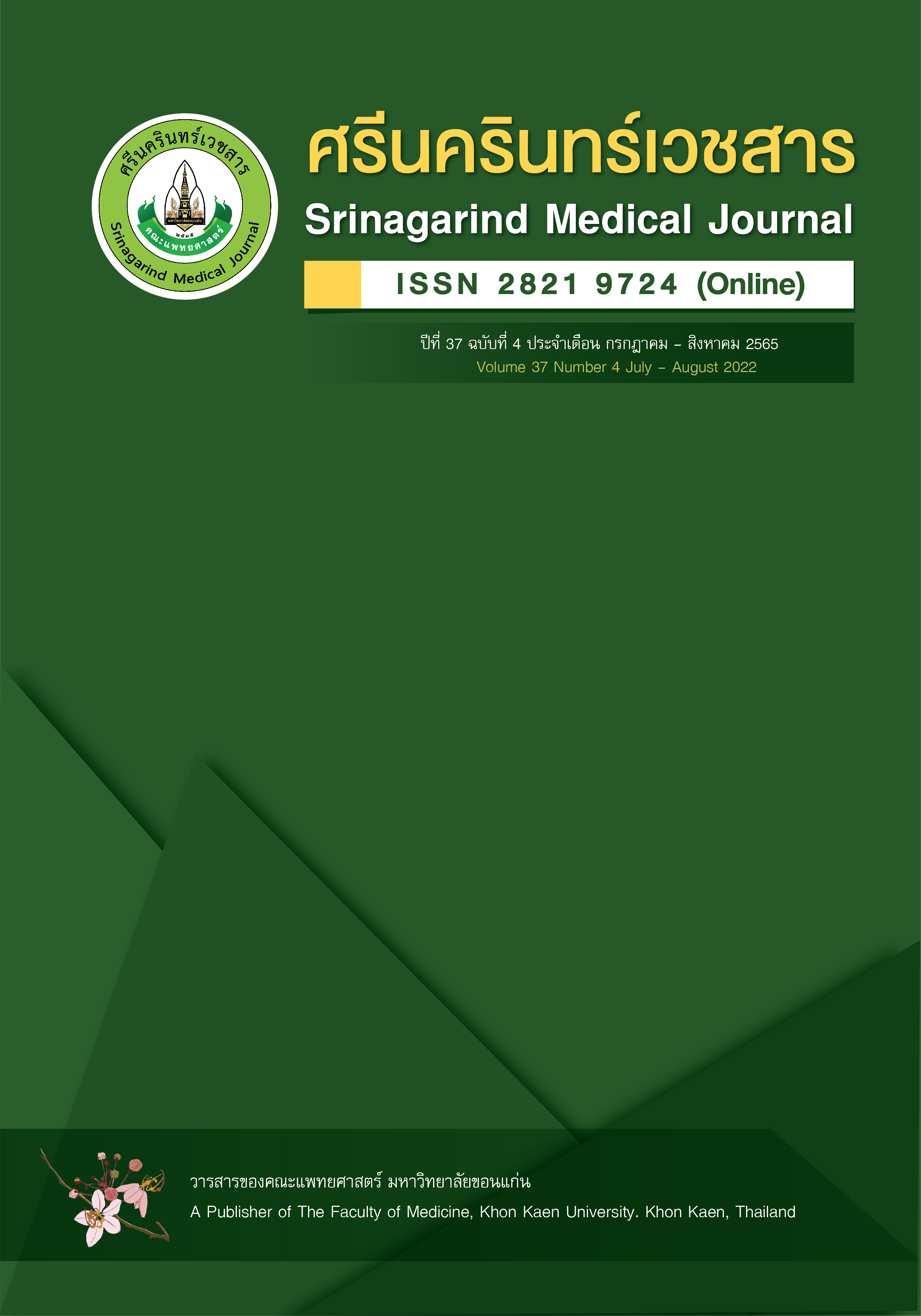ความชุกและปัจจัยเสี่ยงของการติดเชื้อวัณโรคแฝงของบุคลากรทางการแพทย์ ในโรงพยาบาลร้อยเอ็ด
Prevalence and Risk Factors of Latent Tuberculosis Infection among Health Care Workers in Roi Et Hospital
Abstract
หลักการและวัตถุประสงค์: วัณโรคปอดเป็นโรคติดต่อที่เกิดจากเชื้อ Mycobacterium tuberculosis สามารถทนอยู่ในอากาศและสิ่งแวดล้อมได้นาน ติดต่อโดยการหายใจ ไอ จาม หากร่างกายอ่อนแอเชื้อก็จะกำเริบก่อให้เกิดโรคได้ การศึกษานี้มีวัตถุประสงค์เพื่อศึกษาความชุกและปัจจัยเสี่ยงของการติดเชื้อวัณโรคแฝงของบุคลากรทางการแพทย์ในโรงพยาบาลร้อยเอ็ด
วิธีการศึกษา: การศึกษาครั้งนี้เป็นการศึกษาภาคตัดขวางเชิงพรรณนา โดยเก็บข้อมูลจากอาสาสมัครที่เป็นบุคลากรทางการแพทย์ทั้งหมด 663 ราย ดำเนินการสัมภาษณ์และเจาะเลือดเพื่อตรวจ interferon-gamma release assay (IGRA) ที่ห้องปฏิบัติการสำนักงานป้องกันควบคุมโรคที่ 7 ขอนแก่น ระหว่างเดือนมกราคม ถึง เมษายน พ.ศ. 2565 สถิติที่ใช้ในการวิเคราะห์ข้อมูลได้แก่ สถิติเชิงพรรณนา การวิเคราะห์ตัวแปรเชิงเดี่ยว การวิเคราะห์แบบตัวแปรพหุ โดยกำหนดระดับนัยสำคัญที่ p <0.05
ผลการศึกษา: กลุ่มศึกษาทั้งหมด 633 ราย ให้ผลทดสอบ IGRAs Positive 63 ราย มีอัตราความชุก (prevalence rate) LTBI ร้อยละ 9.50 (95%CI=5.77-15.27) ปัจจัยเสี่ยงต่อการติดเชื้อวัณโรคแฝงที่สำคัญได้แก่ ระยะเวลาทำงาน 11-20 ปี (Adj. OR=2.63; 95%CI:1.28-6.44) ระยะเวลาทำงานมากกว่า 20 ปี (Adj. OR=3.33; 95%CI:1.46-6.00) สูบบุหรี่ (Adj. OR=5.0795%CI:1.03-24.81) เป็นโรคหอบหืด (Adj. OR=2.63; 95%CI:1.98-7.05) เคยได้รับยากดภูมิคุ้มกัน (Adj. OR=3.33; 95%CI:1.07-4.52) คนในครอบครัวเคยเป็นวัณโรค (Adj. OR=3.01; 95%CI:1.34-6.76) มีระยะเวลาทำงานใกล้ชิดกับผู้ป่วยวัณโรคมากกว่า 8 ชั่วโมงต่อวัน (Adj. OR=1.87; 95%CI: 1.19-2.54) ปฏิบัติงานในตำแหน่งผู้ช่วยพยาบาล (Adj. OR=3.83; 95%CI:1.46-33.30) และตำแหน่งพยาบาลวิชาชีพ (Adj. OR=5.50 ; 95%CI:1.54-17.87)
สรุป: จากการศึกษานี้พบว่าปัจจัยเสี่ยงต่อการติดเชื้อวัณโรคแฝงในบุคลากรทางการแพทย์ที่สำคัญได้แก่ ระยะเวลาทำงานที่นาน การสูบบุหรี่ การเป็นโรคหอบหืด การใช้ยากดภูมิคุ้มกัน ระยะเวลาทำงานใกล้ชิดกับผู้ป่วยวันโรคมากกว่า 8 ชั่วโมงต่อวัน ผู้ช่วยพยาบาล พยาบาลวิชาชีพและคนในครอบครัวเคยเป็นวัณโรค ซึ่งบุคลากรทางการแพทย์ที่ผลตรวจ IGRA เป็นบวกควรได้รับการรักษาและควรมีการเฝ้าระวังติดตามเป็นพิเศษ
คำสำคัญ: วัณโรคแฝง, บุคลากรทางการแพทย์, Interferon-gamma release assay
Background and objective: Pulmonary tuberculosis is an infectious disease caused by Mycobacterium tuberculosis. The bacteria can survive in environment as aerosols for relatively long time and infects human via breathing, coughing, and sneezing. An infection may remain dormant as latent tuberculosis infection (LTBI) asymptomatic unless one’s immune function become weakness where reactivation and diseases occurs. The objective of this study was to investigate the prevalence and risk factors of LTBI among health care workers in Roi Et Hospital.
Methods: This study was a cross-sectional descriptive study. Data was collected from 663 health care workers by interviewing and blood sampling test for Interferon-gamma release assay (IGRA) in Laboratory at the Office of Disease Prevention and Control 7 Khon Kaen Province from January to April 2022. The univariate and multivariate analysis were used for statistical analyses and p < 0.05 was considered for statistically significance.
Results: On a total 633 participant, Sixty-three participants were tested positive for IGRAs, making the LTBI prevalence of 9.50% (95%CI=5.77-15.27). The main risk factors for LTBI were working time between 11-20 years (Adj.OR=2.63; 95%CI: 1.28-6.44), over 20 years (Adj.OR=3.33; 95%CI:1.46-6.00), cigarettes smoking (Adj.OR=5.07; 95%CI:1.03-24.81), asthma (Adj.OR=2.63; 95%CI:1.98-7.05), Immunosuppressant medications (Adj OR=3.33; 95%CI:1.07-4.52), family history of tuberculosis (Adj. OR=3.01; 95%CI:1.34-6.76), health care-related contact with tuberculosis patients more than 8 hours per day (Adj. OR=1.87; 95%CI: 1.19-2.54), working as nurse assistant (Adj. OR=3.83; 95%CI:1.46-33.30 ), or registered nurse (Adj. OR=5.50 ; 95%CI:1.54-17.87).
Conclusion: This study found preval und of (LTBI) was 9.5 % and risk factors for LTBI in healthcare workers were including long working duration, cigarettes smoking, asthma, immunosuppressants medication, health care-related contact with TB patient more than 8 hours per day, working as nurse assistant or registered nurse, and history of family members had tuberculosis. It is recommended that any healthcare workers who tested positive for IGRA should receive treatment and monitoring.
Keywords: latent tuberculosis infection, health care workers, interferon-gamma release assay


